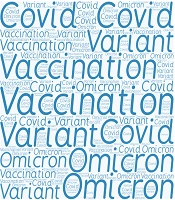People who are moderately or severely immunocompromised may have less protection following vaccination against COVID-19 (1-3). On August 13, 2021, the Advisory Committee on Immunization Practices (ACIP) reported that adult cases with immunocompromising conditions were recommended to inject an extensive preliminary series of three doses of an mRNA COVID-19 vaccine. On September 23, 2021, it provided other suggestions to receive a fourth (booster) dose, and on September 1, 2022, another booster dose for a novel bivalent mRNA COVID-19 was recommended, which contained components of the Omicron (B.1.1.529) BA.4 and BA.5 sub-lineages (4). Limited data are available regarding vaccine effectiveness (VE) of monovalent COVID-19 vaccines in cases who have immunocompromising conditions since the Omicron variant emergence in December 2021 (5).
The B.1.1.529 (Omicron) variant was first detected in the US in November 2021; the BA.1 sub-lineage, which included BA.1.1 has caused the largest increase in the number of COVID-19 patients. Omicron sub-lineages BA.2.12.1 and BA.2 then appeared, accounting for the majority of cases by late April 2022. Newly emerging variants or sub-lineages can reduce estimates of COVID-19 VE, which evade vaccine-related immunity, protection caused by previous COVID-19 infection in unvaccinated cases, or increase time since vaccination. Limited data are available comparing VE when the BA.2/BA.2.12.1 and BA.1 predominated (6).
There are VISION network methods to evaluate VE (3). Accordingly, in adults with the age of ≥ 18 years, eligible medical visits were considered cases hospitalization with one or more immunocompromising conditions and diagnosis of a COVID-19–like illness subjected to SARS-CoV-2 molecular testing ≤ 14 days before < 72 hours following the encounter date. Electronic medical records were used to identify immunocompromising conditions (3). Two-dose vaccination was considered as receiving a second BNT162b2 or mRNA-1273 vaccine dose ≥ 14 days prior to the index date, and three- and four-dose vaccinations as receiving the latest dose ≥ 7 days prior to the index date. No documented COVID-19 vaccine doses were found for unvaccinated cases. Encounters for cases receiving a non-mRNA COVID-19 vaccine, only one dose, more than four doses, dose two less than 14 days before the index date, dose three or four less than 7 days before the index date, receiving doses prior to the vaccine as suggested by ACIP were excluded. The research period started when ≥ 50% of sequenced samples in every study site obtained an Omicron variant according to local monitoring information (between December 16 and 29, 2021) and terminated on August 20, 2022. These two dates for Omicron sub-lineage predominance periods for BA.4/BA.5, BA.2/BA.2.12.1, and BA.1 (the original BA.1.1.529 variant and BA.1 and BA.1.1 sub-lineages) were considered as the site-specific dates of ≥ 50% sub-lineage predominance (5).
We had some limitations. Immunocompromising conditions were according to discharge diagnosis codes, and each code was associated with the immune suppression range. Residual confounding is possible in VE models. As an instance, a history of prior infection cannot be precisely determined but may differ between unvaccinated and vaccinated individuals, which may affect VE estimates. No data were available regarding using outpatient treatments, like nirmatelvir/ritonavir (Paxlovid) or prophylaxis with Evusheld. No SARS-CoV-2 genomic sequencing information was available regarding individual encounters, and the testing date was applied for ecologically probable sub-lineage assignment (6-8).
Therefore, the COVID-19 pandemic has disproportionately affected cases with immunocompromising conditions. While monovalent vaccination provides moderate protection in individuals with immunocompromised conditions, VE showed a decrease compared to pre-Omicron time, especially during recent Omicron sub-lineage predominance time, in spite of expanded dosing suggestions. Although monovalent COVID-19 vaccines provide incomplete protection against hospitalization, those with immunocompromising conditions can take advantage of updated bivalent boosters targeting BA.4/BA.5 sub-lineages. Also, further protective strategies suggested for those with immunocompromising conditions, such as prophylactic antibody therapies, accessibility to using antivirals, and nonpharmaceutical interventions, like using well-fitting respirators or masks, should be regarded. More studies should be done on the VE of updated vaccines in cases with immunocompromising conditions (6).
